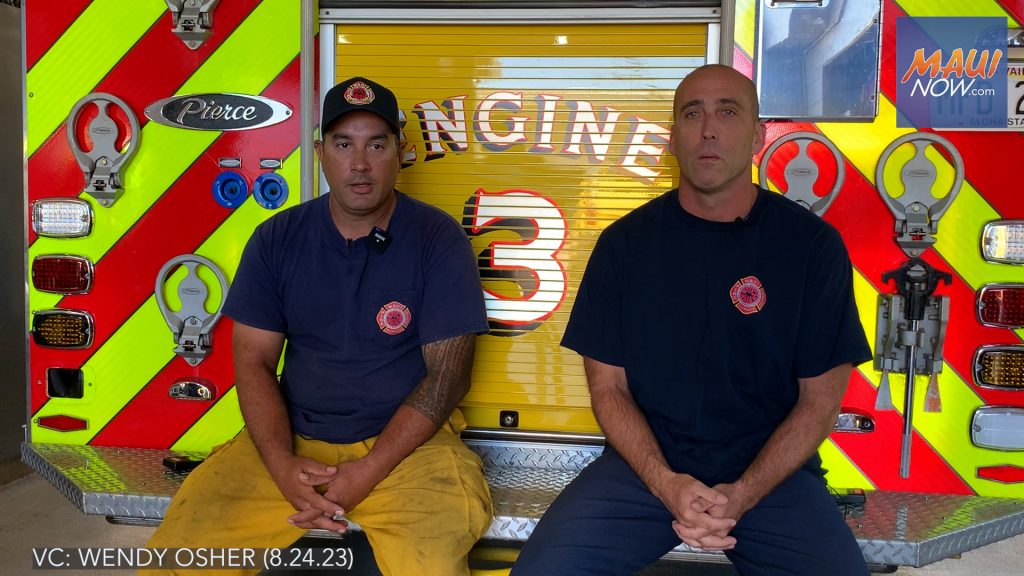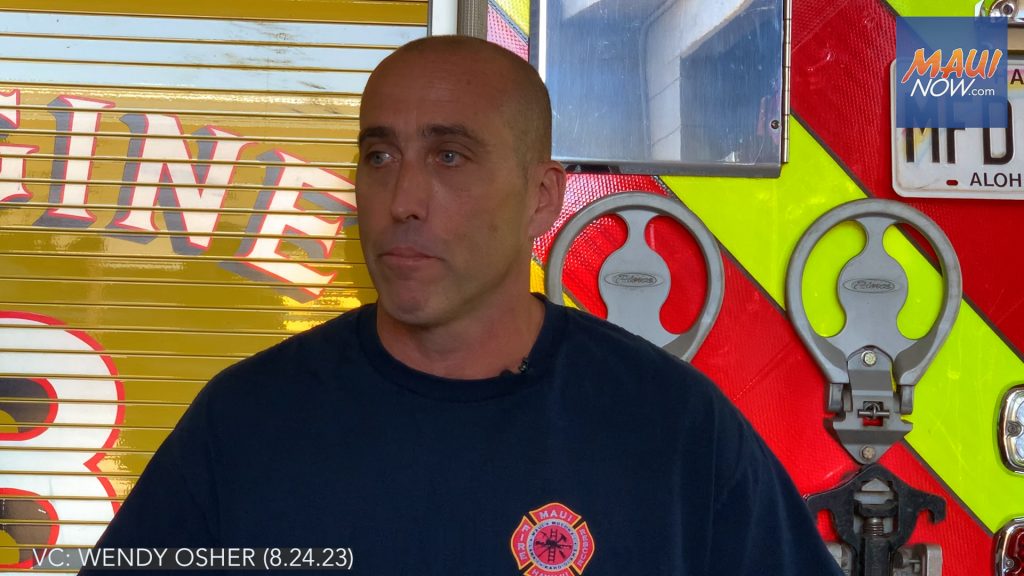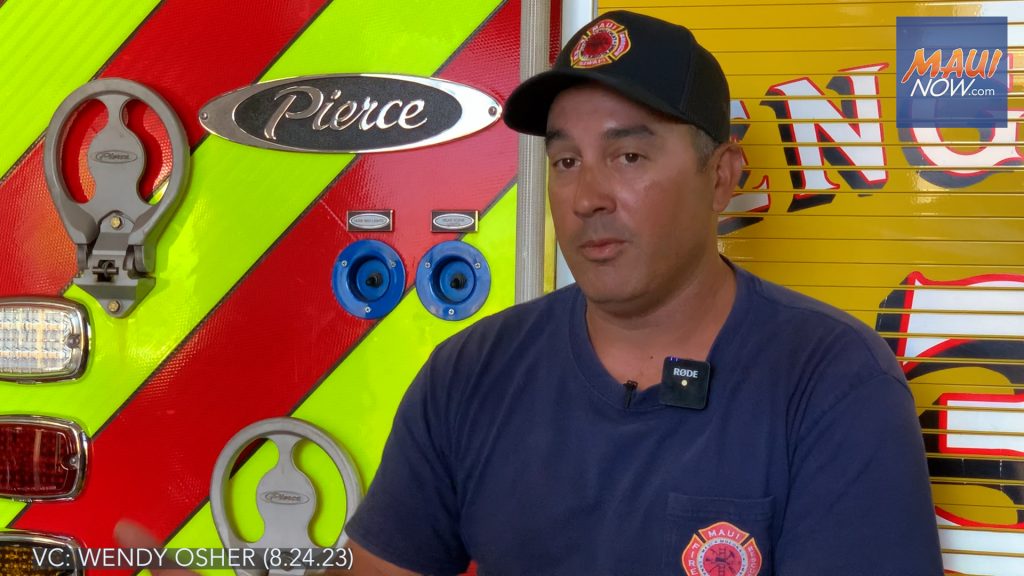Maui firefighters faced blackout conditions, limited water, extreme wind during deadly Aug. 8 Lahaina wildfire

Captain Peter Gand and Firefighter III Cody Cordeiro knew Aug. 8 would be a busy day from the moment they woke up and drove over the ‘Pali’ section of the Honoapiʻilani Highway to work in Lahaina.
“I just remember coming to work knowing we were going to have a high wind event that day. I live in Wailuku. I woke up and noticed it wasn’t too exceptionally windy on that side, but when I got around the ‘Pali’ and looked out to sea, I could see huge areas of swirls, sea foam, and just super intense wind,” said Capt. Peter Gand, who serves with Engine 3 – A Watch.
“I get here pretty early. I kind of knew it was going to be intense, just with the winds. As soon as I came through the ‘Pali’… we knew we were going to be in for a long day,” said Cody Cordeiro, Firefighter III, Tanker Driver, and 15 year veteran of the department.
Cordeiro, who worked to battle the Hurricane Lane fire in Lahaina in 2018, said while winds on that day were impressive, the extreme gusts on Aug. 8 2023 exceeded anything he had ever experienced before.
“It was the windiest day I’ve ever seen in my life, anywhere, ” said Capt. Gand. According to Capt. Gand, the day started off with Ladder crews being called out to ocean rescues, service calls for power lines down, and calls for roofs being blown off throughout Lahaina.
With another large fire already utilizing resources in Kula, Capt. Gand said he knew resources were going to be stretched thin.
At around 6:27 a.m., a brush fire was reported in an area off Lahainaluna Road. County officials reported that the fire was fueled by strong winds from Hurricane Dora, that was passing well south of the islands. It had burned approximately three acres before being declared 100% contained shortly before 9 a.m.
Maui Fire Chief Brad Ventura said crews sat on the fire until after 1 p.m. with no further activity. At around 3 p.m., Chief Ventura said another fire started in Lahaina. It is still unclear if the fire was a flare-up or a new fire. In a press release issued later that day, county officials said power outages in the area were impacting the ability to pump water.
Blackout conditions and limited water
Crews found themselves constantly repositioning in an effort to battle the blaze and keep crews safe.
“We noticed that it was starting to threaten some structures and we had to reposition to engage… It was just before we could really get everything set up… we just realized it was jumping from structure to structure. We noticed power lines were going down all around us, and our means of egress had been compromised, so we had to reposition from that,” said Capt. Gand, who has been a firefighter for 18 years on Maui.

“The entire time, I was just focused on the safety of my crew, making sure we had a safe position to fight the fire from,” said Capt. Gand. “I was just constantly evaluating what was taking place around us. When I saw that potentially our means of getting out was becoming compromised, it was time to move and get out of there.”
“We relocated to another position that we thought was a safe spot to try to stop the fire. We got a water supply over there. We started to attack the fire, and basically the same thing happened, so we had to reposition a third time after that,” said Capt. Gand.
“Once we realized that the fire load was such that one pumper wasn’t going to be enough, was when we would have to reposition. We would notice, looking downhill, you could see from the point we were trying to make our stand from, you could look down and three to four houses down, you’d notice there was a roof on fire over there, propane tanks blowing off. You could hear at one point venting. It sounded like a jet engine going off,” said Capt. Gand.
“My crew was just covered in smoke, and we were just constantly getting bombarded by the winds. We’d get our lines off the truck and the gusts of winds were so strong you could barely stand up. It felt like it was going to blow you over. You couldn’t see. You had ember and ash blowing in your face. Half of my crew lost their houses in this fire. They knew that their houses were gone, and they just didn’t stop. They kept on going, pushing through and they didn’t hesitate throughout the night,”
—Capt. Peter Gand
“I’m on the tanker, so my truck has 2,000 gallons of water,” said Cordeiro. “But even that—going back to how fast the fire was spreading—my 15 years in the department I’ve never seen structure fires spread like a wildfire would. It just ran on us. And to see my truck be inefficient. I mean, I’m dropping all my water on structures, have to drive a long way (because the hydrants are dry) to fill up. By the time I come back, that fire that I was putting out has now burnt that house down and spread to another three or four more houses down the line,” said Cordeiro.
Cordeiro said that while he was attached to Capt. Gand in the beginning part of the fire, he ended up being one of the only sources of water, so he was being shuttled around and was linking in with different companies. There was also difficulty finding crews because of the “blackout” conditions caused by heavy smoke.

“From all our guys who had boots on the ground, they’re walking in, and it’s uncertainty because it’s hard to explain—we’re driving in and my truck is huge, and it disappears in black smoke. The engines go in—they disappear. You don’t know where guys are in the street. It’s completely blacked out. It’s in the middle of the day, but we didn’t have any light on the inside.
—Cody Cordeiro, Firefighter III, Tanker Driver
“All we’re seeing is a structure here, let’s try and put this out,” said Cordeiro. With limited water and strong winds making hose streams ineffective, Cordeiro said he felt like the cards were stacked against him. “We’re trying as best as we can, but nothing was working in our favor.”
ARTICLE CONTINUES BELOW ADARTICLE CONTINUES BELOW AD“Getting that truck in position and basically squeezing the trigger and watching that straight stream fly back at the tanker or just shatter… or you’re trying to hit here, and it ends up over there… That’s as useless as I’ve ever felt…
—Cody Cordeiro, Firefighter III, Tanker Driver
Cordeiro was having to drive an extra five minutes to fill up the tanker. He said the water source was low, so it took a little bit longer than usual. “It normally takes two minutes to fill that tanker up, but it was taking 5-10 minutes. And all that time, the houses just kept on rolling,” he said.
Realization, shifting gears, staying engaged
“It’s frustrating because we take pride in our ability to protect the town, so when we saw that we were quickly getting overwhelmed, we were trying not to get tunnel vision or too focused on one particular task. I’m trying to keep a cool head, and make sure my crew is safe, and making sure we’re effectively fighting the fire from the position that we’re at, that’s not going to get us killed. That’s pretty much all I was thinking about,” said Capt. Gand.
“We were engaged at a spot where we thought we were able to make a good stand, and we were safely able to engage in the fire. I remember we all looked back towards Lahaina town and it was just a huge black smoke cloud coming off the entire town. It wan’t really going up so much as out to sea, just because the winds were so strong, it kept the smoke low to the horizon. But at that point we knew—black smoke is an indication of a structure fire, so at that point we knew most of the town was probably burning.”
—Peter Gand, Capt. Engine 3 – A Watch
“All the crew that works with us, they knew their houses were probably burning. Their loved ones, their whereabouts were unknown. Personally, friends of mine that live in Lahaina, I was concerned about. We had no way of knowing what their location was. We didn’t really have time to even think about it. We just kept working, doing our job,” said Capt. Gand. “We’d figure it out later.”
“Two guys, we had to drive right by their house. I didn’t notice their house had burned… but there was a power line down across the road and we had to cut down a tree and a fence post to get around it and out of there,” said Capt. Gand. When he asked about their homes, he got confirmation that the structures had burned and pets were unaccounted for.
Another stop was Kupuohi Street where a commercial structure was on fire. “We were just constantly shifting gears between different types of structure fires, jumping in and out of the truck,” said Capt. Gand. “We were going in there not knowing if we were going to come out.”
“Once we knew we were out of water, and our ability to fight the fire was limited, we shifted our objectives to just trying to evacuate people. We were driving through the neighborhoods, driving through Wahikuli. We were concerned at that point that we were going to be in there with the fire coming and power lines were continuing to come down throughout the night. We were concerned that we were going to get stuck in there as the fire came closer. We were assisting people with limited mobility getting out of their houses,” said Capt. Gand.
At one point the fire had advanced forcing the evacuation of the Lahaina Civic Center, which was being used as a shelter. The crew assisted in loading evacuees into buses to relocate them to Maui Preparatory Academy, which served as an alternate evacuation site.
Disbelief. No time to process. Duty calls.
When the sun rose the next day, Capt. Gand and his fellow firefighters were in disbelief. “We couldn’t even believe the level of devastation. It looked like a bomb went off. To be honest, at that point I didn’t really have time to process it yet because we were going through town, still picking up people that had been stranded in town, people that were injured or just needed a ride out of there,” he said.
“And then there was still the southern flank of the fire burning towards Launiupoko that was still active… I was on the southern flank of the fire for the remainder of the day, the next day. We were trying to protect the Launiupoko subdivision at that point,” according to Capt. Gand.
Cordeiro said he is still in disbelief. “We do take pride and we’re the best at it, but we couldn’t, like I said, stop what was going on. But we still had the fire to fight the next day. At that time the wind had actually eased up on us, and we could actually make progress,” he said.
“I din’t really know how full the extent was, especially Front Street,” said Cordeiro. “I can’t believe that just happened. I never thought that would ever happen. It’s always—we’re going to stop this. We always do. This is that one off when we couldn’t.”
Unfair advantage. Grief sets in.
Reflecting upon the ‘what ifs,’ Capt. Gand said:
“Honestly, I think we could have had 100 fire trucks down there and it wouldn’t have made a difference.”
—Peter Gand, Capt. Engine 3 – A Watch
The typical response package for a single family residence structure fire is two engines and a support company. For a second alarm with a working fire, that support bumps up to four engines and two support companies. “That’s basically what we had for the entire town,” said Capt. Gand who expressed grief. “We did our best and I’m sorry for everybody who lost their home and for everybody who passed away in the fire.”
“For all the loved ones that they lost, it’s tragic and all of us wish we could have done more,” said Cordeiro. “We still have a community to protect. We haven’t given up on that… We did everything we possibly could. We ran out of water. We were where we were supposed to be at that particular moment. We just didn’t have a chance. It was an unfair advantage,” he said.
“This is our community. It’s not just our job. We have four other people on this watch at this station whose houses burned, so it has affected everybody personally. We just continue to do our job, and it’s rough, but we’re just staying focused on what we’re here to do,” said Capt. Gand.
“For the crews that were working that day, they didn’t flinch. They kept showing up day in and day out, even though all of their stuff is gone. They’re trying to figure out where they’re going to live. But they’re still showing up, eager to work. We still have a job to do. They never hesitated… to me that’s amazing. I didn’t lose a house, but I can see it in them. It hurts,” said Cordeiro.
“We did the best we could. Every one of us that was fighting this fire gave it everything, and then some, and it just wasn’t enough. But we’re still here. We’re still going to protect you.”
—Cody Cordeiro, Firefighter III, Tanker Driver









